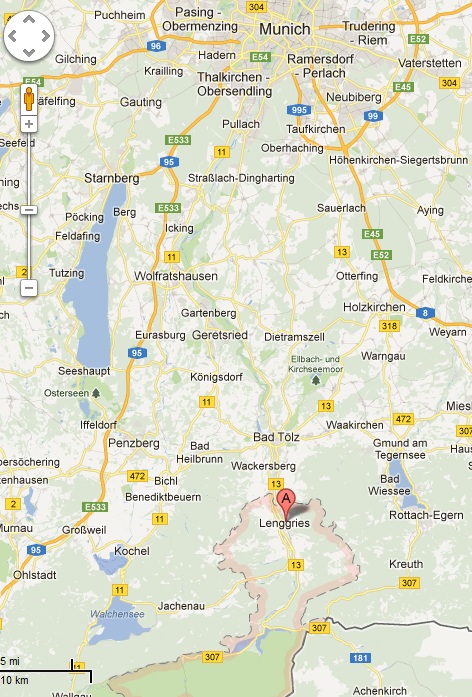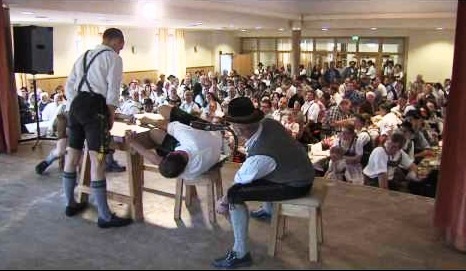Friday Photo Favorite: Marienkäfer
 Friday, August 31, 2012 at 9:00
Friday, August 31, 2012 at 9:00 Or Mimi-käfer, as a friend's young daughter likes to call them.

 Frau A ...
Frau A ...  Post a Comment
Post a Comment  Friday, August 31, 2012 at 9:00
Friday, August 31, 2012 at 9:00 Or Mimi-käfer, as a friend's young daughter likes to call them.

 Frau A ...
Frau A ...  Post a Comment
Post a Comment  Wednesday, August 29, 2012 at 6:00
Wednesday, August 29, 2012 at 6:00 Frau A and I are getting married soon. (!) For the wedding reception, we wanted to bring a sense of Bavaria back home to the U.S.. It would be fun, interesting, and something (hopefully) unique for our family and friends.
The first step was speaking with the caterers about food. They had never done käsespätzle and other dishes before, but seemed pretty professional and took the time to research recipes, etc. We'll see how their food turns out...
But that triggered some memories and thoughts about how the fast/convenience culture of the U.S. simply does not "allow" some true German foods to be made (correctly) and served in America. We could, but we don't.
The main reason? Patience. Or, lack thereof. Here are some examples:
 1) The whole, rotisserie-roasted chickens over here (the most popular food at Oktoberfest, by the way) always seem to be jucier and taste better.
1) The whole, rotisserie-roasted chickens over here (the most popular food at Oktoberfest, by the way) always seem to be jucier and taste better.
I asked a store that sells them daily, and the department head said that they brine the chickens for at least a day before roasting them.
Jamie Oliver says to do this too, but I think typically Americans just rub some spices on the outside and get cooking (or stores skip brining to cut costs).
 2) Similarly, I noticed that I actually *like* the sauerkraut here. Growing up, I always hated sauerkraut at picnics, etc.. So I asked a traditional restaurant (Augustiner) that serves the good stuff about the general approach.
2) Similarly, I noticed that I actually *like* the sauerkraut here. Growing up, I always hated sauerkraut at picnics, etc.. So I asked a traditional restaurant (Augustiner) that serves the good stuff about the general approach.
They said the cabbage should be cured in salt at least 3 days to ferment enough. (This web page and this page say 2-4 weeks.) This is what generates the right texture & flavor. Most U.S. sauerkraut is just cooked cabbage.
Now I'm NOT saying that traditional German food is "better". (A lot is drowned in sauce or generally not to my taste.) The point is that by shortcutting some original techniques, you don't get the real, tasty version.
Another place we noticed where the lack of patience (or refusal to put in extra time and cost) prevents us from finding (and then liking) authentic German foods? Desserts. An underrated part of German cuisine.
 3) Frau A and I needed to select a wedding cake, of course. One of the treats we love here is Prinzregententorte. Highly recommended.
3) Frau A and I needed to select a wedding cake, of course. One of the treats we love here is Prinzregententorte. Highly recommended.
The thing about this dessert is that it has "at least" (from Wikipedia) six thin layers of cake, each one separated by a thin layer of chocolate/hazelnut buttercream. I counted at various bakeries here, and usually see seven layers. That's a LOT of work to assemble!
My colleague's grandma used to make this, and it took her half the day.
I did a Google search for German bakeries in Charleston, SC. The first thing that popped up was Rococo German Bakery. My first reaction was to be surprised at the name (Rococo is obviously not German) but what the heck. They did not have Prinzregententorte on their website, so I called and asked if the can make it. The response?
"We don't know what that is." Major fail. Then I checked their website further...
- Only 1 of the 19 items shown in "Cakes and Pies" is even remotely German (Black Forest Cake... but it looks like it is made with American super-sweet buttercream frosting rather than whipped cream). They do list a 'German Chocolate Cake', but this is not German! (It's American, actually. Dallas, Texas! See the link to Wikipedia.)
 - Only 1 of their 7 items in "Cookies" is consistently found here -- the black & white frosted sugar cookie -- but it's not truly German. (Chocolate chip and macaroons are available here and there... the chocolate chip never very good.) At Rococo, no Christmas classics -- which are good all year -- like vanillakipferl, zimtsterne, or even lebkuchen are available. Maybe in December?
- Only 1 of their 7 items in "Cookies" is consistently found here -- the black & white frosted sugar cookie -- but it's not truly German. (Chocolate chip and macaroons are available here and there... the chocolate chip never very good.) At Rococo, no Christmas classics -- which are good all year -- like vanillakipferl, zimtsterne, or even lebkuchen are available. Maybe in December?
 - Of the 15 items in "Pastry", they do offer apfelstudel (technically Austrian, but good enough).
- Of the 15 items in "Pastry", they do offer apfelstudel (technically Austrian, but good enough).
And one positive surprise: bienenstich (bee sting)! I rarely see this in the U.S., but it's a great coffee-time indulgence. Crumb cakes are popular here, but with more fruit than crumb (vs. the Rococo photo). Fruit roulade and lemon bars are available here, but are French and American repsectively. Overall, here's where they come the closest to a "German" bakery (breads not included).
I don't mean to pick on Rococo, just wanted to show an example of the gap.
One last point -- the other thing that creates this divide is the use preservatives (whether its desserts, bratwurst, or bread). There's a reason that Germans shop for bread at least every other day (often daily).
There are no preservatives, so it doesn't last. But that's the way it goes here... and it tastes pretty good.
 Monday, August 27, 2012 at 6:00
Monday, August 27, 2012 at 6:00 I was looking at various web sites for German products that I could send to some friends in the U.S.. At one online import store (U.S. based), I came across an odd combination -- a beer stein with the Lord's Prayer on it!
This is taller (16 inches) than normal, holding 1.5 liters. (Small steins hold typically 0.5L, and large ones 1L.)
The text is in German, and it's made in Germany. It just doesn't seem very German to put Bible verses on a stein.
The Catholic Bavarians and southern Germans generally don't quote the Bible much, preferring symbols and images. So I checked -- the producer is in northern Germany (albeit southeast of Cologne, a very Catholic city too).
Maybe marketing knows something we don't? This is not cheap either, at $115! Not sure what to say... prosit?
 Sunday, August 26, 2012 at 8:00
Sunday, August 26, 2012 at 8:00 It's been a packed summer of sports, with the European Football Championship (Poland/Ukraine) and Summer Olympics (London). Now it's back to basics as the Budesliga fussball season gets underway.
In that spirit, you need to see this video of German soccer fans after a World Cup game in 2010, "cheering" on a woman as she tries to park her car. It's OK to laugh at this, right?
 Herr J ...
Herr J ...  Post a Comment
Post a Comment  Friday, August 24, 2012 at 19:06
Friday, August 24, 2012 at 19:06  Herr J ...
Herr J ...  Post a Comment
Post a Comment  Wednesday, August 22, 2012 at 8:00
Wednesday, August 22, 2012 at 8:00 One could probably fill an encyclopedia of YouTube videos created by bored guys.
I found this one because I'm looking into getting a "tough" compact camera -- waterproof to 10m, drop-proof, freeze-proof, etc. (There seem to be some decent models by Panasonic, Olympus, and Canon.)
In this video, they take the Olympus TG-1, turn on the video recording, and dunk it in a pitcher of lager:
I'm wondering two things...
1) Where did they film this? It looks like a chemistry lab from 1920.
2) Did they drink the beer afterwards?
 Herr J ...
Herr J ...  Post a Comment
Post a Comment  Just for Fun tagged
Just for Fun tagged  beer,
beer,  beer camera,
beer camera,  underwater camera ...
underwater camera ...  Print Article
Print Article  Email Article
Email Article  Share Article
Share Article  Monday, August 20, 2012 at 13:10
Monday, August 20, 2012 at 13:10 On August 12 2012, the 35th annual Alpine Finger Wrestling Championships were held in the town of Lenggries, Germany. Lenggries is 1.5 hours from Munich by car/train, and about 10 miles north of the border with Austria:

According to The Local (a web site with German news in English), "finger wrestling" (fingerhakeln in German) is basically a one-finger tug-of-war taking place across a table. A contestant wins when he pulls the other across a set line on the table.
It is a formal, regulated sport in Bavaria and parts of Austria with rules governing the dimensions of the leather band used between competitors fingers, size of the table, and weight classes. The Championships are rotated between Alpine towns in Bavaria and Austria.
Short YouTube video of the event:
And another video that shows one wrestling match:
Tradition says that finger wrestling was used as a way to settle disputes in the mountain towns, as far back as the 17th century. Other sites claim it was a drinking game, and that a written record from 1878 said "one frequently sees, in Tirol, men with fingers bent nearly double on the right hand". Ouch.
Here is an old photo from Schwangau, Germany (thanks to trachtler.org):
Also, women are not allowed to compete. "It just does not fit" said one member of the Isargau Finger Wrestling Club (the host of the 2012 Championship).
Before the start of a match -- two "wrestlers" and a referee (from an article at The Mirror):
This year, 150 men participated, most dressed in traditional clothes -- lederhosen. They take the, um, sport, quite seriously. Many start training months in advance using weights, stretch-bands, etc. In photos, you'll see their fingers (always the middle one) chalked up like a weightlifter. Regardless of preparation, strained tendons, bleeding fingers, and pulled muscles are common occurrences.
Close-up of the leather band connecting the competitors (from sulekha.com):
The intensity and PAIN are obvious during the match. I'm fascinated with the attenpts to gain leverage by getting low, bracing feet below the table or knees on the edge of the table, etc (again from The Local):
Behind each wrestler sits another guy, who will catch his teammate if he flies backwards. The crowd this year looked to be perhaps 150 people, but a lot of press organizations picked up the news story:

Almost forgot: the team from Ammergau (in the Bavarian Alps) won the competition. (I could not find the list of individual winners.) Congratulations!
 Herr J ...
Herr J ...  Post a Comment
Post a Comment  Germany & German Culture,
Germany & German Culture,  Sports tagged
Sports tagged  finger wrestling ...
finger wrestling ...  Print Article
Print Article  Email Article
Email Article  Share Article
Share Article 